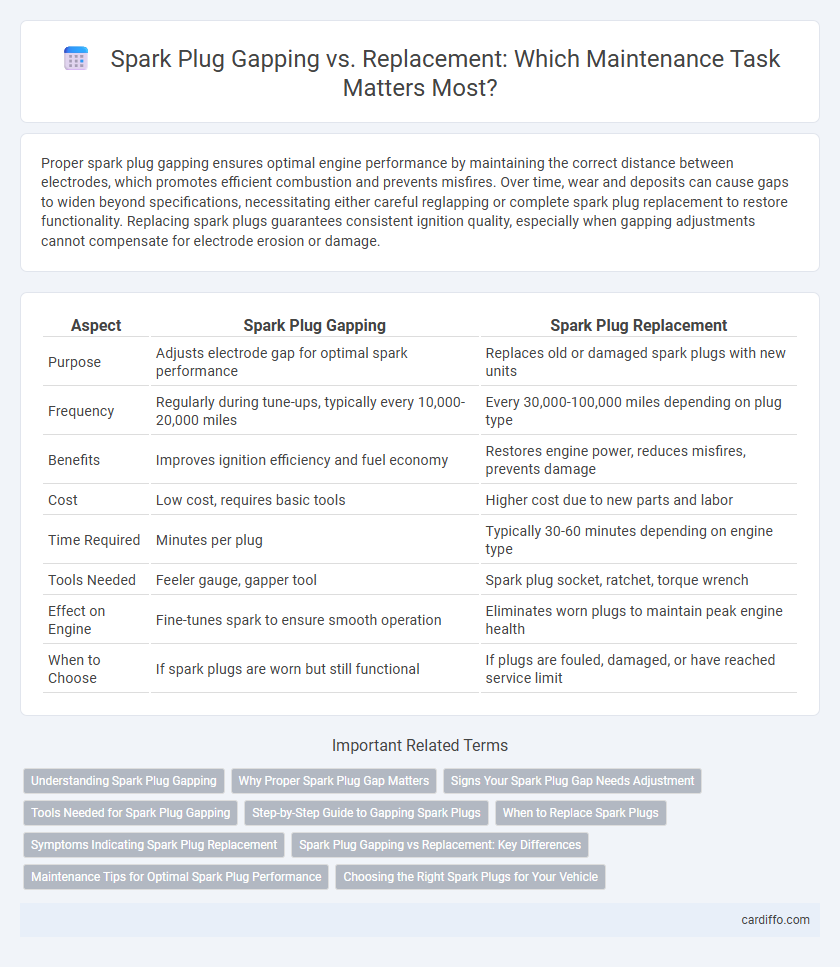Proper spark plug gapping ensures optimal engine performance by maintaining the correct distance between electrodes, which promotes efficient combustion and prevents misfires. Over time, wear and deposits can cause gaps to widen beyond specifications, necessitating either careful reglapping or complete spark plug replacement to restore functionality. Replacing spark plugs guarantees consistent ignition quality, especially when gapping adjustments cannot compensate for electrode erosion or damage.
Table of Comparison
| Aspect | Spark Plug Gapping | Spark Plug Replacement |
|---|---|---|
| Purpose | Adjusts electrode gap for optimal spark performance | Replaces old or damaged spark plugs with new units |
| Frequency | Regularly during tune-ups, typically every 10,000-20,000 miles | Every 30,000-100,000 miles depending on plug type |
| Benefits | Improves ignition efficiency and fuel economy | Restores engine power, reduces misfires, prevents damage |
| Cost | Low cost, requires basic tools | Higher cost due to new parts and labor |
| Time Required | Minutes per plug | Typically 30-60 minutes depending on engine type |
| Tools Needed | Feeler gauge, gapper tool | Spark plug socket, ratchet, torque wrench |
| Effect on Engine | Fine-tunes spark to ensure smooth operation | Eliminates worn plugs to maintain peak engine health |
| When to Choose | If spark plugs are worn but still functional | If plugs are fouled, damaged, or have reached service limit |
Understanding Spark Plug Gapping
Proper spark plug gapping ensures optimal ignition performance by maintaining the correct distance between the electrodes, which directly affects engine efficiency and fuel combustion. Over time, spark plug gaps can widen due to electrode wear or deposits, leading to misfires and reduced power, making regular inspection essential. Understanding spark plug gapping helps determine whether adjusting the gap suffices or if complete spark plug replacement is necessary to restore proper engine function.
Why Proper Spark Plug Gap Matters
Proper spark plug gap ensures optimal combustion efficiency by creating the right spark intensity needed for fuel ignition. A correctly gapped spark plug improves engine performance, fuel economy, and reduces misfires compared to relying solely on spark plug replacement. Maintaining the ideal gap length prevents uneven wear and prolongs the lifespan of spark plugs, supporting consistent engine maintenance.
Signs Your Spark Plug Gap Needs Adjustment
Uneven engine idling, decreased fuel efficiency, and difficulty starting the vehicle are key signs your spark plug gap needs adjustment. If misfires or poor acceleration occur, the spark plug gap may be improperly set, affecting combustion performance. Regular inspection of the spark plug gap ensures optimal ignition and prevents premature spark plug replacement.
Tools Needed for Spark Plug Gapping
Spark plug gapping requires precise tools such as a feeler gauge or a specialized spark plug gapper to measure and adjust the electrode gap accurately, ensuring optimal engine performance and fuel efficiency. Unlike spark plug replacement, which primarily needs a spark plug socket and ratchet, gapping tools are critical for fine-tuning existing plugs without removal and replacement. Proper utilization of gapping instruments prevents misfires and maintains ignition system reliability, prolonging the spark plug's functional lifespan.
Step-by-Step Guide to Gapping Spark Plugs
Proper spark plug gapping ensures optimal engine performance and fuel efficiency by maintaining the precise gap specified by the manufacturer, typically between 0.025 to 0.045 inches. Use a spark plug gap tool to carefully measure and adjust the gap by gently bending the ground electrode without damaging the ceramic insulator. Regularly inspect for wear, fouling, or damage as excessive gap adjustment or compromised plugs necessitate replacement to prevent misfires and engine inefficiency.
When to Replace Spark Plugs
Spark plug replacement is necessary when the electrode gap exceeds the manufacturer's specifications, causing misfires or poor engine performance. Visual signs such as worn electrodes, heavy carbon deposits, or cracked insulators indicate that the plugs have reached the end of their usable life. Regular inspection intervals, typically every 30,000 to 100,000 miles depending on the spark plug type, help determine when replacement is more effective than simply regapping.
Symptoms Indicating Spark Plug Replacement
Symptoms indicating spark plug replacement include persistent engine misfires, difficulty starting the engine, and decreased fuel efficiency. Worn or improperly gapped spark plugs cause irregular combustion, leading to rough idling and poor acceleration. Regular inspection reveals corrosion, excessive wear, or carbon deposits, signaling the need for immediate replacement to maintain optimal engine performance.
Spark Plug Gapping vs Replacement: Key Differences
Spark plug gapping involves adjusting the distance between the electrodes to ensure optimal spark efficiency, which directly affects engine performance and fuel combustion. In contrast, spark plug replacement is necessary when electrodes are worn, fouled, or damaged, leading to misfires or reduced engine power. Proper gapping can extend the lifespan of spark plugs, but replacement is critical when performance degradation becomes significant.
Maintenance Tips for Optimal Spark Plug Performance
Regularly checking and maintaining the correct spark plug gap ensures efficient combustion, improves engine performance, and prevents misfires. While adjusting the gap can extend spark plug life, replacing worn or fouled spark plugs at manufacturer-recommended intervals guarantees optimal ignition and fuel efficiency. Using a precise gap tool and adhering to vehicle specifications are essential maintenance tips for sustaining spark plug performance.
Choosing the Right Spark Plugs for Your Vehicle
Proper spark plug gapping ensures optimal engine performance by maintaining the correct distance for efficient spark ignition, directly impacting fuel efficiency and emissions. Regular spark plug replacement is essential to prevent fouling, wear, and corrosion that degrade engine power and combustion quality. Selecting the right spark plugs involves considering vehicle specifications, engine type, and manufacturer recommendations to balance durability and performance.
Spark plug gapping vs Spark plug replacement Infographic

 cardiffo.com
cardiffo.com